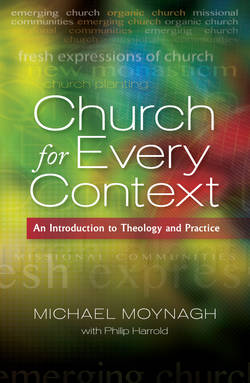Читать книгу Church for Every Context - Michael Moynagh - Страница 32
На сайте Литреса книга снята с продажи.
From mission team to centre mission
ОглавлениеPaul followed the pattern of Jesus, who both assembled a team of disciples and sent them to announce the kingdom in pairs (Luke 10.1). He had a strong sense of being part of a team. ‘I planted the seed, Apollos watered it, but God made it grow’ (1 Cor. 3.6). ‘For we are God’s fellow workers’ (1 Cor. 3.9). He saw himself as collaborating with others both to initiate church and build it up into a ‘temple’, whose holy living made it a fit place for God’s presence (Barton, 2003, pp. 37–8).
On Paul’s so-called ‘first’ missionary journey,6 he and Barnabas were commissioned as a pair, but they quickly brought in John Mark as a helper (Acts 13.5). It seems that they preferred to work as a three. When they acted as a pair in Galatia, it was because Mark had left them rather than out of choice (Acts 13.13). On his second journey, Paul started with Silas but soon added Timothy (Acts 16.1–2). Being half Greek, Timothy came from a similar background to some of the people Paul was seeking to reach and strengthened the team’s ethnic mix (Hopkins, 1988, p. 12). Later, as Paul’s teams grew in size they became more culturally diverse, which must have further helped them to relate to the diversity of people they encountered (Acts 20.4).
Members joining or leaving the team frequently did so in pairs – Silas and Timothy in Acts 18.5, Timothy and Erastus in Acts 19.22 and presumably Paul and Luke in Acts 20.6 (Hopkins, 1988, p. 12). This highlights again how teams were central to Paul’s approach.
Where possible, Paul seems to have preached the gospel while others on the team did the work of catechesis (Acts 18.5; 1 Cor. 1.14–17). Is this why Luke, on the second and third journeys, became a valued member? Was he perhaps collecting stories about Jesus, which he passed on to the new converts and eventually became his Gospel?7 Paul’s teams expanded as his work matured. On his third journey, he was accompanied by at least eight people for a period.8 Larger teams enabled Paul to keep breaking new ground while still supporting churches recently established. When disputes threatened the church at Corinth, for example, Paul sent Timothy to help resolve the situation (1 Cor. 4.17).
His teams were largely self-funding – Paul was keen not to depend financially on the people he sought to reach (1 Thess. 2.9). On his first journey, Paul stayed scarcely long enough in one place to get established in his leather-working trade, so it may be that he drew on funds from his wealthy background or that he and Barnabas were supported by the Christians at Antioch and Cyprus.9 On his second journey, however, he found work in Corinth (Acts 18.3) and later in Ephesus. In Acts 20.34 Paul reminds the Ephesian elders that his paid work helped to support not only himself, but his companions. At times his fellow workers supported him (2 Cor. 11.9). Resources were pooled within the team.
Being financially self-sufficient had many attractions. It modelled sacrificial support for others (Acts 20.35), the workplace almost certainly contained evangelistic opportunities10 and mission was not held up through lack of funds. Though Paul also received financial gifts from some of his new churches (for example Phil. 4.14–8), it is striking that for much of the time the extraordinary fruitfulness of his ministry depended on activity largely in his spare time (though he might not recognize the language).
The expansion of Paul’s teams as his work progressed was a significant strategic development. They drew on ‘centre missions’ – young congregations, equal in status, networked with each other in major cities, such as Ephesus, and which then became the bases for mission (Gehring, 2004, pp. 180–2). These bases sent workers to help Paul and his permanent colleagues for a limited time. Temporary workers ranged from householders like Stephanas to the slave, Onesimus, from the house of Philemon. Nearly a fifth were women (Schnabel, 2008, p. 251). Here was a very different approach to mission than the centrally organized team sent out from Antioch, travelling from place to place. Co-workers came and went from a variety of congregations, which often acted on their own initiative (for example Acts 18.27).
Like Ephesus, where a missional centre reached out to its hinterland, congregations increasingly engaged in evangelism. First Corinthians 9.1–2 implies that a number of apostles – church founders – emerged (see Eph. 4.11). Gifts of the Spirit to the church included evangelists (Eph. 4.11) and the witness of individual Christians was assumed to be desirable (1 Cor. 7.16; Titus 2.10; 1 Peter 3.1–2). Howard Marshall concludes:
The strong evidence of Acts is that local congregations expanded and grew through the efforts of their members; the story of the Hellenists who fled from Jerusalem and the growth of the church at Antioch is representative of what must have happened more widely. (Marshall, 2000, p. 263)
In a remarkably short time, Paul’s outreach had evolved from mission team to centre mission, based on a growing number of reproducing congregations. At the heart of centre mission was Paul’s team, involving a complex web of relationships in which over 50 people made various contributions (Dunn, 2009, pp. 566–71). As Dunn notes, Paul must have been a most accomplished leader who inspired personal loyalty and commitment (Dunn, 2009, p. 572).
